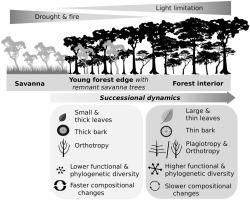Perspectives in Plant Ecology, Evolution and Systematics ( IF 3.5 ) Pub Date : 2021-07-30 , DOI: 10.1016/j.ppees.2021.125630 Grégoire Blanchard 1, 2, 3 , Thomas Ibanez 1 , François Munoz 4 , David Bruy 1, 3 , Christelle Hely 5, 6 , Jérôme Munzinger 1 , Philippe Birnbaum 1, 3, 7

|
In the context of global change, tropical forests are increasingly affected by fires. Understanding the ecological processes driving forest recovery in fire-modified landscapes is a critical issue.
We analyzed spatial and temporal (8 years) changes in functional and phylogenetic composition of tree communities during forest post-fire recovery in anthropogenic savannas. We used null models to infer the main assembly processes driving forest succession along three 90-m transects running from an advancing savanna-forest edge to forest interior in New Caledonia. We also evaluated if successional changes differed between large and small trees, or depended on the demography of remnant savanna trees.
We found coordinated shifts from drought- and fire-resistance towards shade-tolerance strategies, involving leaf, stem, and architectural traits along transects. Our results indicate stronger environmental filtering and faster temporal changes in composition of young edge communities. In forest interior, our results suggest slower compositional changes, with an important role of light limitation in community assembly. These non-random patterns depended on both the decline of savanna trees and compositional changes among forest species. We also found contrasting community patterns depending on tree size, supporting a stronger influence of environmental filtering on small trees.
Our work emphasized the dominance of deterministic assembly processes driving tropical forest post-fire succession. Our study suggests that fire and drought drive environmental filtering during early succession at the forest edge, entailing constraints on multiple functional dimensions. As succession progresses, light-limitation becomes a stronger driver of community assembly, and community composition becomes more stable in time. Our study provides insights for a better understanding of the processes guiding tropical forest succession in the particular context of post-fire forest recovery.
中文翻译:

人为稀树草原热带森林火灾后演替过程中树木群落聚集的驱动因素
在全球变化的背景下,热带森林越来越多地受到火灾的影响。了解推动火灾改造景观中森林恢复的生态过程是一个关键问题。
我们分析了人为稀树草原火灾后森林恢复期间树木群落功能和系统发育组成的空间和时间(8 年)变化。我们使用空模型来推断沿着三个 90 米长的横断面推动森林演替的主要组装过程,这些横断面从前进的热带稀树草原森林边缘延伸到新喀里多尼亚的森林内部。我们还评估了大树和小树之间的演替变化是否不同,或者取决于残余稀树草原树木的人口统计。
我们发现从抗旱和耐火到耐阴策略的协调转变,涉及沿横断面的叶、茎和建筑特征。我们的结果表明,年轻边缘社区的组成有更强的环境过滤和更快的时间变化。在森林内部,我们的结果表明组成变化较慢,光限制在群落组装中起着重要作用。这些非随机模式取决于热带稀树草原树木的衰退和森林物种之间的组成变化。我们还发现根据树木大小的不同群落模式,支持环境过滤对小树的更大影响。
我们的工作强调了驱动热带森林火灾后演替的确定性组装过程的主导地位。我们的研究表明,在森林边缘的早期演替过程中,火灾和干旱推动了环境过滤,从而限制了多个功能维度。随着演替的进行,光限制成为社区聚集的更强大驱动力,社区组成在时间上变得更加稳定。我们的研究为更好地理解在火灾后森林恢复的特定背景下指导热带森林演替的过程提供了见解。











































 京公网安备 11010802027423号
京公网安备 11010802027423号